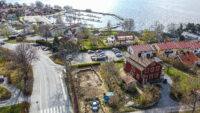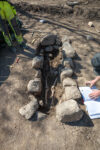 Seven early Christian graves from the Viking Age have been discovered in Sigtuna, southeastern Sweden. They were found in an archaeological survey at the site of a planned residential building on a hill on the western edge of the historic town, and date to the end of the 10th century when the hill was on the outskirts of the town.
Seven early Christian graves from the Viking Age have been discovered in Sigtuna, southeastern Sweden. They were found in an archaeological survey at the site of a planned residential building on a hill on the western edge of the historic town, and date to the end of the 10th century when the hill was on the outskirts of the town.
The seven graves contain the remains of eight individuals as one of them was a double burial of two infants who likely died in or shortly after childbirth. Objects were found in the graves — coins, a comb, a knife, the remains of a belt — typical of pagan funerary practices, but the east-west orientation indicates these were Christian burials. They are markedly different, however, from previous early Christian burials found in Sigtuna. Several of the deceased were placed in wooden coffins that were then buried on a stone-lined bed and covered with more stones. None of the coffins survive, but iron nails attest to their use.
 This tomb design hasn’t been found in the town before, although some have been found in the wider area. Before this discovery, the earliest Christian burials in Sigtuna were spare, simple east-west inhumations with no grave goods. Archaeologists have postulated that there must have been knowledgeable and experienced priests in Sigtuna to ensure a strict adherence to Christian burial practice during what was still a transitional period between belief systems. If so, the recently-unearthed hilltop graves predated their arrival.
This tomb design hasn’t been found in the town before, although some have been found in the wider area. Before this discovery, the earliest Christian burials in Sigtuna were spare, simple east-west inhumations with no grave goods. Archaeologists have postulated that there must have been knowledgeable and experienced priests in Sigtuna to ensure a strict adherence to Christian burial practice during what was still a transitional period between belief systems. If so, the recently-unearthed hilltop graves predated their arrival.
Sigtuna was founded on the banks of Lake Mälaren in the 970s by King Eric the Victorious. It was briefly that capital under the reign of Eric’s son Olof Skötkonung, first Christian king of Sweden. The first Swedish coins were struck by the mint in Sigtuna from the 990s until the early 1030s. Its growth  and prosperity began to decline when the episcopal seat was moved to Old Uppsala around 1164, and the town lost its central economic, political and religious significance to its neighbors.
and prosperity began to decline when the episcopal seat was moved to Old Uppsala around 1164, and the town lost its central economic, political and religious significance to its neighbors.
The bones and grave goods are now being studied and analyzed. Researchers hope to be able to pinpoint the dates of the burials more precisely to shed new light on early Christian burials in Sigtuna. The objects will be conserved for later display at the Sigtuna Museum.